Global Strategy Analysis and Practice
VerifiedAdded on 2023/05/30
|14
|3937
|365
AI Summary
This report analyses the external and internal environment of Nokia by taking use of different strategic tools. It also illustrates about the strategy that is made by the organisation so as to improve its performance. At last it evaluates about the strategic options available with the firm for its growth.
Contribute Materials
Your contribution can guide someone’s learning journey. Share your
documents today.
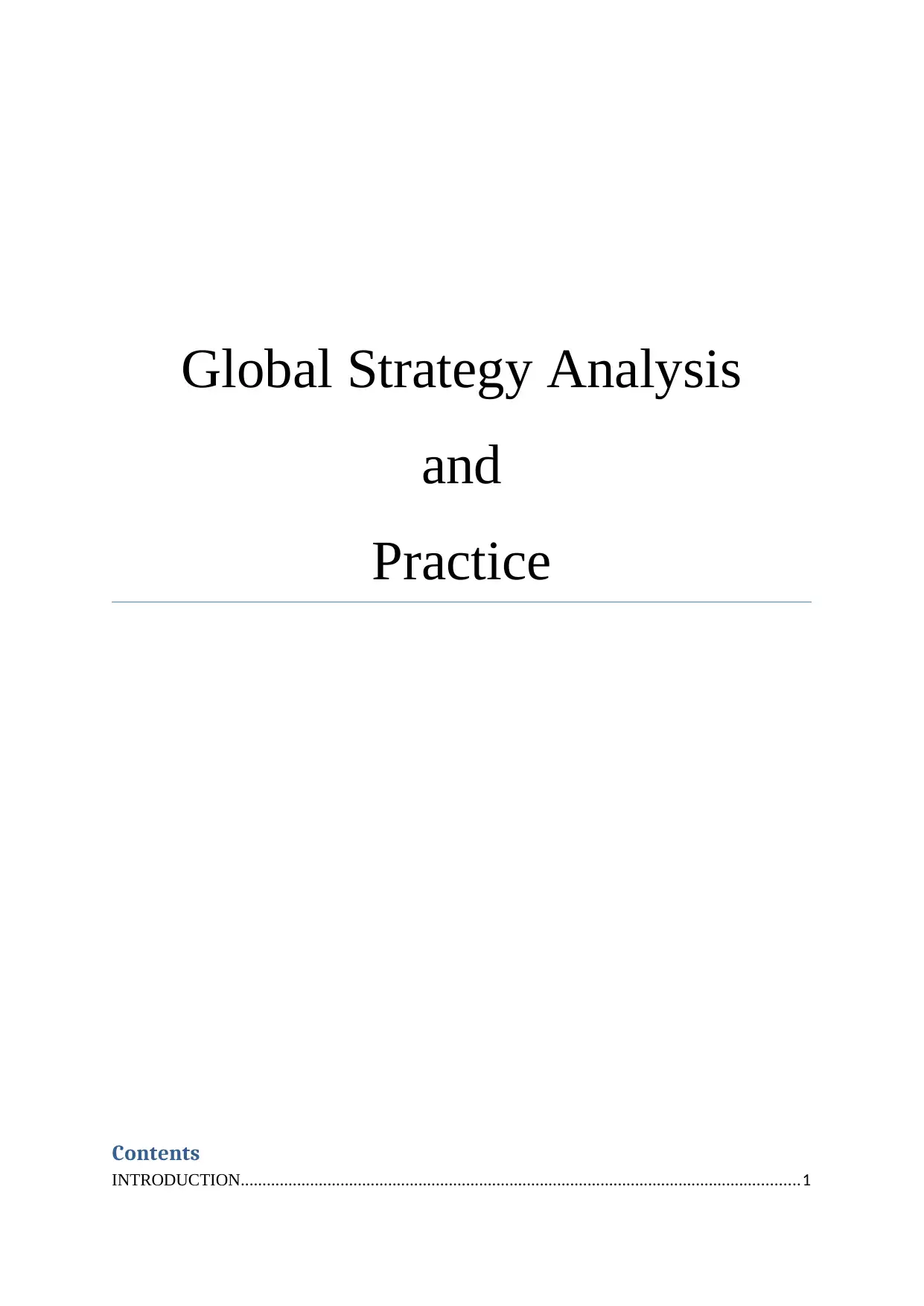
Global Strategy Analysis
and
Practice
Contents
INTRODUCTION.................................................................................................................................1
and
Practice
Contents
INTRODUCTION.................................................................................................................................1
Secure Best Marks with AI Grader
Need help grading? Try our AI Grader for instant feedback on your assignments.
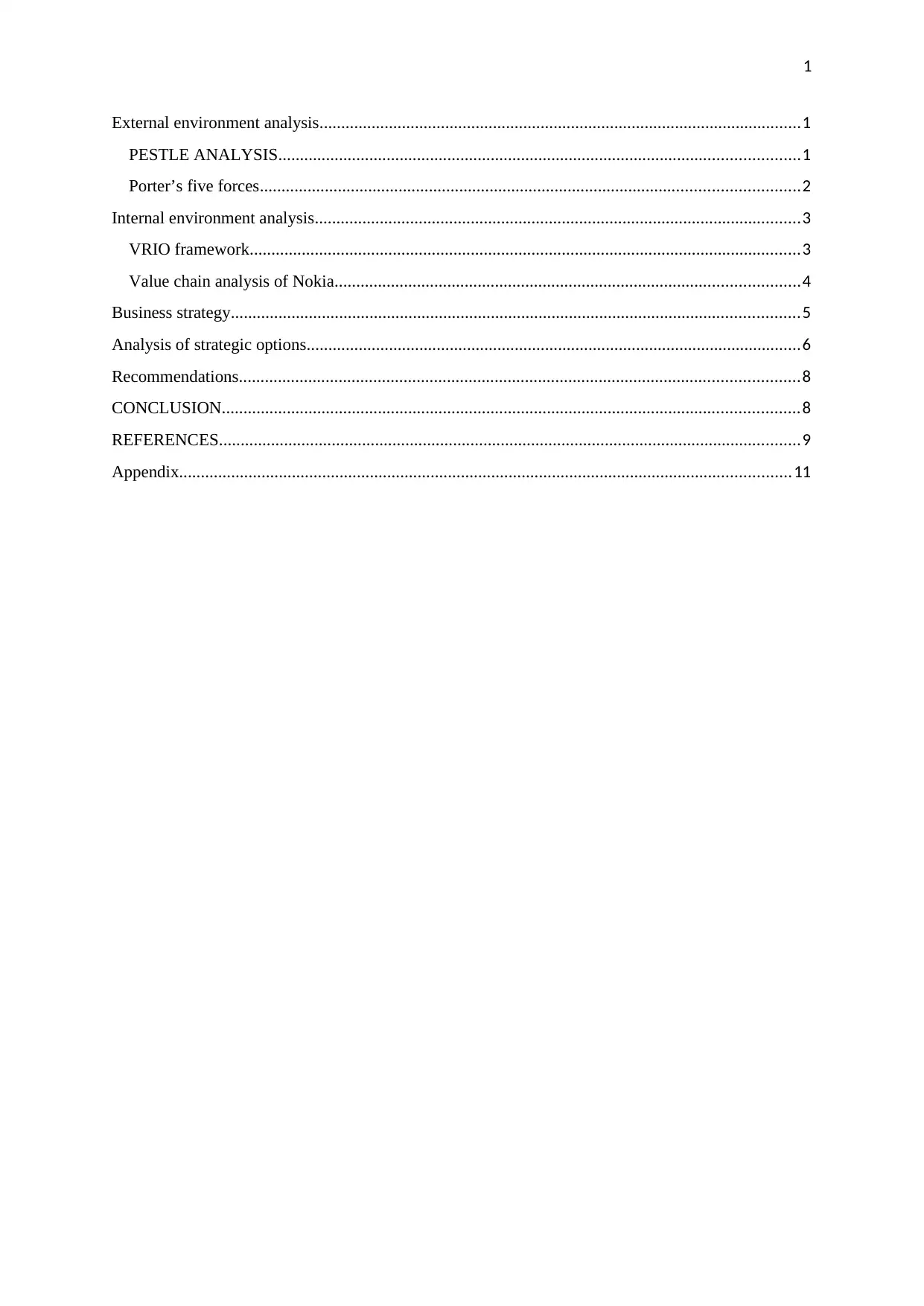
1
External environment analysis...............................................................................................................1
PESTLE ANALYSIS........................................................................................................................1
Porter’s five forces............................................................................................................................2
Internal environment analysis................................................................................................................3
VRIO framework...............................................................................................................................3
Value chain analysis of Nokia...........................................................................................................4
Business strategy...................................................................................................................................5
Analysis of strategic options..................................................................................................................6
Recommendations.................................................................................................................................8
CONCLUSION.....................................................................................................................................8
REFERENCES......................................................................................................................................9
Appendix.............................................................................................................................................11
External environment analysis...............................................................................................................1
PESTLE ANALYSIS........................................................................................................................1
Porter’s five forces............................................................................................................................2
Internal environment analysis................................................................................................................3
VRIO framework...............................................................................................................................3
Value chain analysis of Nokia...........................................................................................................4
Business strategy...................................................................................................................................5
Analysis of strategic options..................................................................................................................6
Recommendations.................................................................................................................................8
CONCLUSION.....................................................................................................................................8
REFERENCES......................................................................................................................................9
Appendix.............................................................................................................................................11
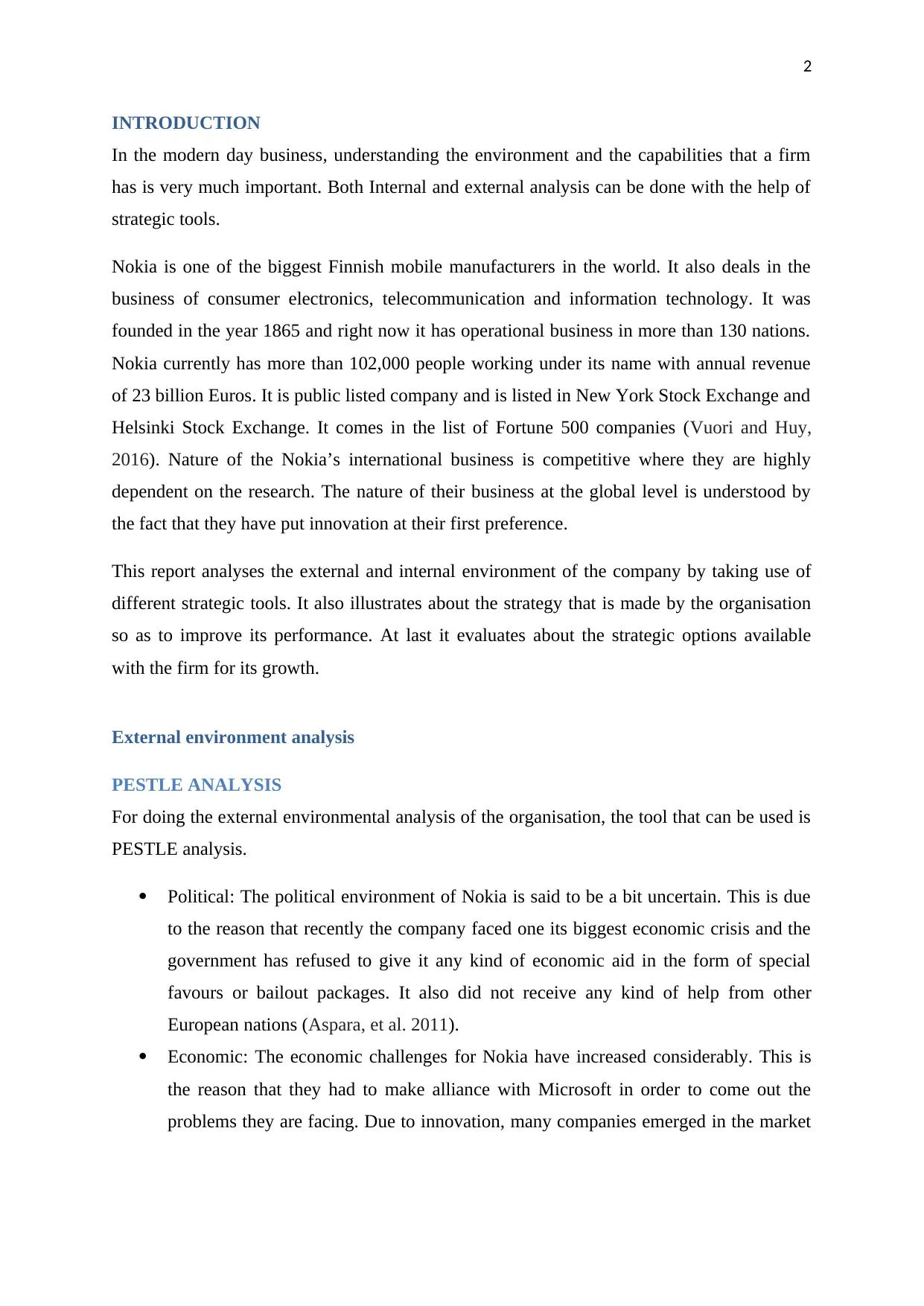
2
INTRODUCTION
In the modern day business, understanding the environment and the capabilities that a firm
has is very much important. Both Internal and external analysis can be done with the help of
strategic tools.
Nokia is one of the biggest Finnish mobile manufacturers in the world. It also deals in the
business of consumer electronics, telecommunication and information technology. It was
founded in the year 1865 and right now it has operational business in more than 130 nations.
Nokia currently has more than 102,000 people working under its name with annual revenue
of 23 billion Euros. It is public listed company and is listed in New York Stock Exchange and
Helsinki Stock Exchange. It comes in the list of Fortune 500 companies (Vuori and Huy,
2016). Nature of the Nokia’s international business is competitive where they are highly
dependent on the research. The nature of their business at the global level is understood by
the fact that they have put innovation at their first preference.
This report analyses the external and internal environment of the company by taking use of
different strategic tools. It also illustrates about the strategy that is made by the organisation
so as to improve its performance. At last it evaluates about the strategic options available
with the firm for its growth.
External environment analysis
PESTLE ANALYSIS
For doing the external environmental analysis of the organisation, the tool that can be used is
PESTLE analysis.
Political: The political environment of Nokia is said to be a bit uncertain. This is due
to the reason that recently the company faced one its biggest economic crisis and the
government has refused to give it any kind of economic aid in the form of special
favours or bailout packages. It also did not receive any kind of help from other
European nations (Aspara, et al. 2011).
Economic: The economic challenges for Nokia have increased considerably. This is
the reason that they had to make alliance with Microsoft in order to come out the
problems they are facing. Due to innovation, many companies emerged in the market
INTRODUCTION
In the modern day business, understanding the environment and the capabilities that a firm
has is very much important. Both Internal and external analysis can be done with the help of
strategic tools.
Nokia is one of the biggest Finnish mobile manufacturers in the world. It also deals in the
business of consumer electronics, telecommunication and information technology. It was
founded in the year 1865 and right now it has operational business in more than 130 nations.
Nokia currently has more than 102,000 people working under its name with annual revenue
of 23 billion Euros. It is public listed company and is listed in New York Stock Exchange and
Helsinki Stock Exchange. It comes in the list of Fortune 500 companies (Vuori and Huy,
2016). Nature of the Nokia’s international business is competitive where they are highly
dependent on the research. The nature of their business at the global level is understood by
the fact that they have put innovation at their first preference.
This report analyses the external and internal environment of the company by taking use of
different strategic tools. It also illustrates about the strategy that is made by the organisation
so as to improve its performance. At last it evaluates about the strategic options available
with the firm for its growth.
External environment analysis
PESTLE ANALYSIS
For doing the external environmental analysis of the organisation, the tool that can be used is
PESTLE analysis.
Political: The political environment of Nokia is said to be a bit uncertain. This is due
to the reason that recently the company faced one its biggest economic crisis and the
government has refused to give it any kind of economic aid in the form of special
favours or bailout packages. It also did not receive any kind of help from other
European nations (Aspara, et al. 2011).
Economic: The economic challenges for Nokia have increased considerably. This is
the reason that they had to make alliance with Microsoft in order to come out the
problems they are facing. Due to innovation, many companies emerged in the market
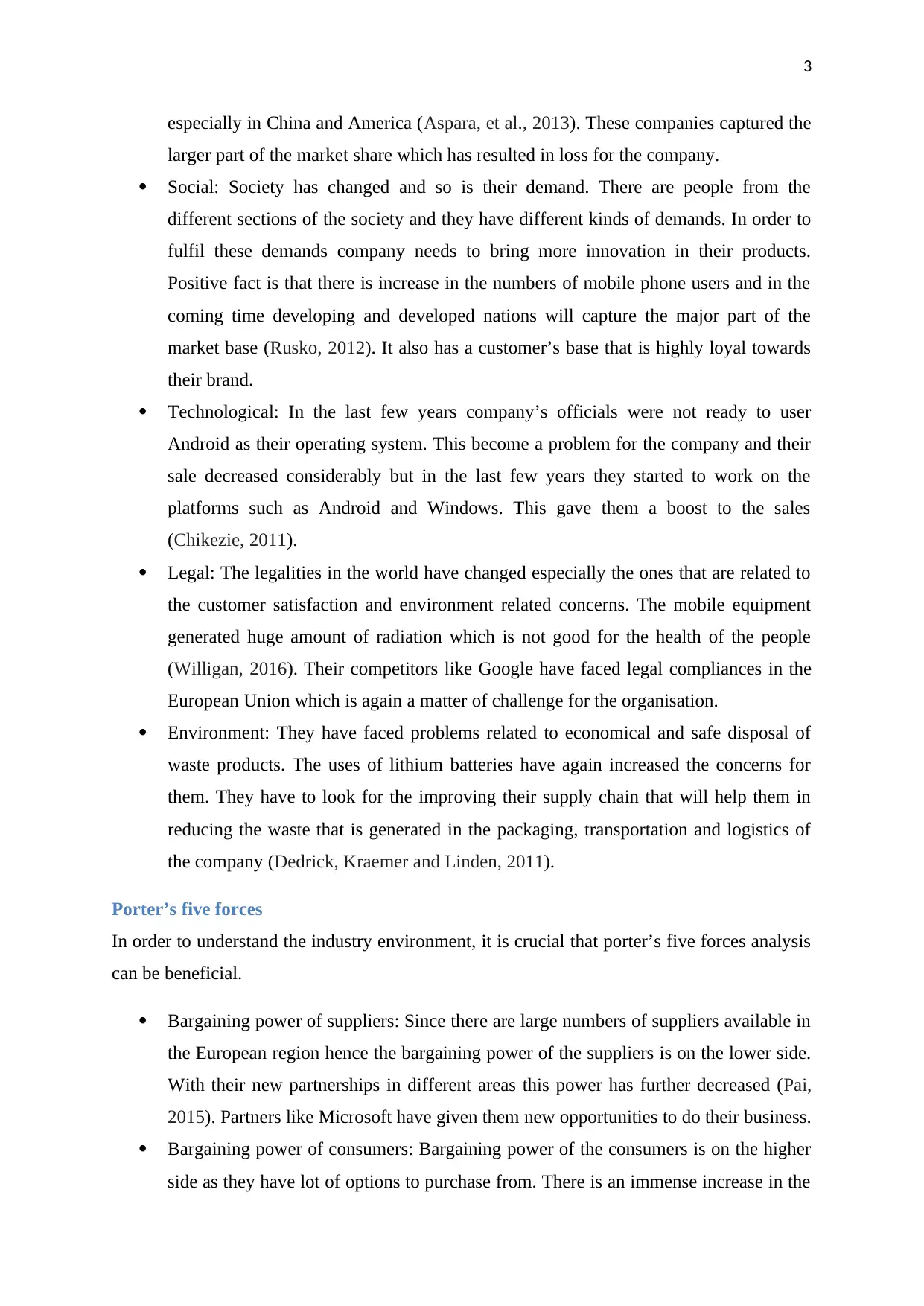
3
especially in China and America (Aspara, et al., 2013). These companies captured the
larger part of the market share which has resulted in loss for the company.
Social: Society has changed and so is their demand. There are people from the
different sections of the society and they have different kinds of demands. In order to
fulfil these demands company needs to bring more innovation in their products.
Positive fact is that there is increase in the numbers of mobile phone users and in the
coming time developing and developed nations will capture the major part of the
market base (Rusko, 2012). It also has a customer’s base that is highly loyal towards
their brand.
Technological: In the last few years company’s officials were not ready to user
Android as their operating system. This become a problem for the company and their
sale decreased considerably but in the last few years they started to work on the
platforms such as Android and Windows. This gave them a boost to the sales
(Chikezie, 2011).
Legal: The legalities in the world have changed especially the ones that are related to
the customer satisfaction and environment related concerns. The mobile equipment
generated huge amount of radiation which is not good for the health of the people
(Willigan, 2016). Their competitors like Google have faced legal compliances in the
European Union which is again a matter of challenge for the organisation.
Environment: They have faced problems related to economical and safe disposal of
waste products. The uses of lithium batteries have again increased the concerns for
them. They have to look for the improving their supply chain that will help them in
reducing the waste that is generated in the packaging, transportation and logistics of
the company (Dedrick, Kraemer and Linden, 2011).
Porter’s five forces
In order to understand the industry environment, it is crucial that porter’s five forces analysis
can be beneficial.
Bargaining power of suppliers: Since there are large numbers of suppliers available in
the European region hence the bargaining power of the suppliers is on the lower side.
With their new partnerships in different areas this power has further decreased (Pai,
2015). Partners like Microsoft have given them new opportunities to do their business.
Bargaining power of consumers: Bargaining power of the consumers is on the higher
side as they have lot of options to purchase from. There is an immense increase in the
especially in China and America (Aspara, et al., 2013). These companies captured the
larger part of the market share which has resulted in loss for the company.
Social: Society has changed and so is their demand. There are people from the
different sections of the society and they have different kinds of demands. In order to
fulfil these demands company needs to bring more innovation in their products.
Positive fact is that there is increase in the numbers of mobile phone users and in the
coming time developing and developed nations will capture the major part of the
market base (Rusko, 2012). It also has a customer’s base that is highly loyal towards
their brand.
Technological: In the last few years company’s officials were not ready to user
Android as their operating system. This become a problem for the company and their
sale decreased considerably but in the last few years they started to work on the
platforms such as Android and Windows. This gave them a boost to the sales
(Chikezie, 2011).
Legal: The legalities in the world have changed especially the ones that are related to
the customer satisfaction and environment related concerns. The mobile equipment
generated huge amount of radiation which is not good for the health of the people
(Willigan, 2016). Their competitors like Google have faced legal compliances in the
European Union which is again a matter of challenge for the organisation.
Environment: They have faced problems related to economical and safe disposal of
waste products. The uses of lithium batteries have again increased the concerns for
them. They have to look for the improving their supply chain that will help them in
reducing the waste that is generated in the packaging, transportation and logistics of
the company (Dedrick, Kraemer and Linden, 2011).
Porter’s five forces
In order to understand the industry environment, it is crucial that porter’s five forces analysis
can be beneficial.
Bargaining power of suppliers: Since there are large numbers of suppliers available in
the European region hence the bargaining power of the suppliers is on the lower side.
With their new partnerships in different areas this power has further decreased (Pai,
2015). Partners like Microsoft have given them new opportunities to do their business.
Bargaining power of consumers: Bargaining power of the consumers is on the higher
side as they have lot of options to purchase from. There is an immense increase in the
Secure Best Marks with AI Grader
Need help grading? Try our AI Grader for instant feedback on your assignments.
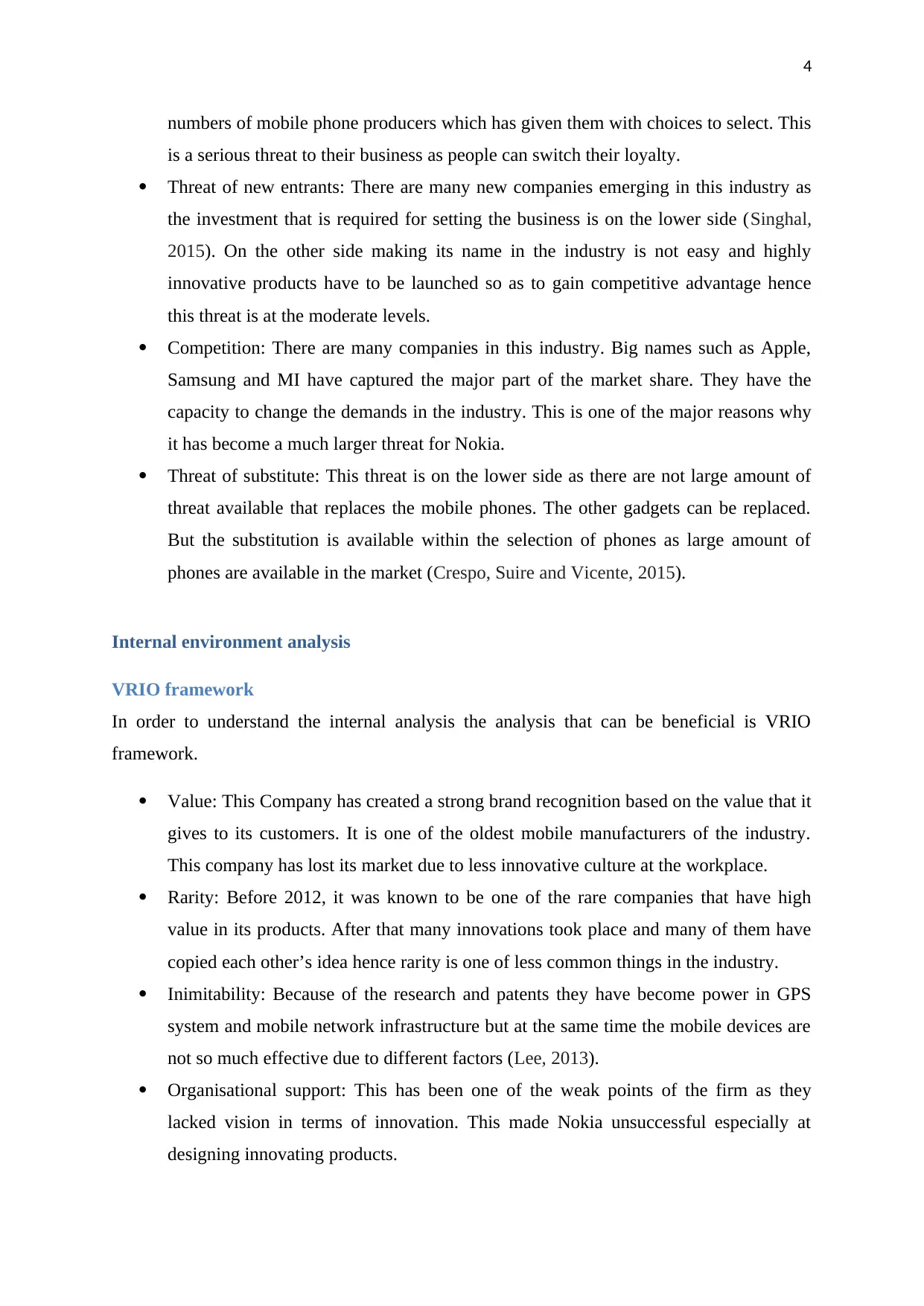
4
numbers of mobile phone producers which has given them with choices to select. This
is a serious threat to their business as people can switch their loyalty.
Threat of new entrants: There are many new companies emerging in this industry as
the investment that is required for setting the business is on the lower side (Singhal,
2015). On the other side making its name in the industry is not easy and highly
innovative products have to be launched so as to gain competitive advantage hence
this threat is at the moderate levels.
Competition: There are many companies in this industry. Big names such as Apple,
Samsung and MI have captured the major part of the market share. They have the
capacity to change the demands in the industry. This is one of the major reasons why
it has become a much larger threat for Nokia.
Threat of substitute: This threat is on the lower side as there are not large amount of
threat available that replaces the mobile phones. The other gadgets can be replaced.
But the substitution is available within the selection of phones as large amount of
phones are available in the market (Crespo, Suire and Vicente, 2015).
Internal environment analysis
VRIO framework
In order to understand the internal analysis the analysis that can be beneficial is VRIO
framework.
Value: This Company has created a strong brand recognition based on the value that it
gives to its customers. It is one of the oldest mobile manufacturers of the industry.
This company has lost its market due to less innovative culture at the workplace.
Rarity: Before 2012, it was known to be one of the rare companies that have high
value in its products. After that many innovations took place and many of them have
copied each other’s idea hence rarity is one of less common things in the industry.
Inimitability: Because of the research and patents they have become power in GPS
system and mobile network infrastructure but at the same time the mobile devices are
not so much effective due to different factors (Lee, 2013).
Organisational support: This has been one of the weak points of the firm as they
lacked vision in terms of innovation. This made Nokia unsuccessful especially at
designing innovating products.
numbers of mobile phone producers which has given them with choices to select. This
is a serious threat to their business as people can switch their loyalty.
Threat of new entrants: There are many new companies emerging in this industry as
the investment that is required for setting the business is on the lower side (Singhal,
2015). On the other side making its name in the industry is not easy and highly
innovative products have to be launched so as to gain competitive advantage hence
this threat is at the moderate levels.
Competition: There are many companies in this industry. Big names such as Apple,
Samsung and MI have captured the major part of the market share. They have the
capacity to change the demands in the industry. This is one of the major reasons why
it has become a much larger threat for Nokia.
Threat of substitute: This threat is on the lower side as there are not large amount of
threat available that replaces the mobile phones. The other gadgets can be replaced.
But the substitution is available within the selection of phones as large amount of
phones are available in the market (Crespo, Suire and Vicente, 2015).
Internal environment analysis
VRIO framework
In order to understand the internal analysis the analysis that can be beneficial is VRIO
framework.
Value: This Company has created a strong brand recognition based on the value that it
gives to its customers. It is one of the oldest mobile manufacturers of the industry.
This company has lost its market due to less innovative culture at the workplace.
Rarity: Before 2012, it was known to be one of the rare companies that have high
value in its products. After that many innovations took place and many of them have
copied each other’s idea hence rarity is one of less common things in the industry.
Inimitability: Because of the research and patents they have become power in GPS
system and mobile network infrastructure but at the same time the mobile devices are
not so much effective due to different factors (Lee, 2013).
Organisational support: This has been one of the weak points of the firm as they
lacked vision in terms of innovation. This made Nokia unsuccessful especially at
designing innovating products.
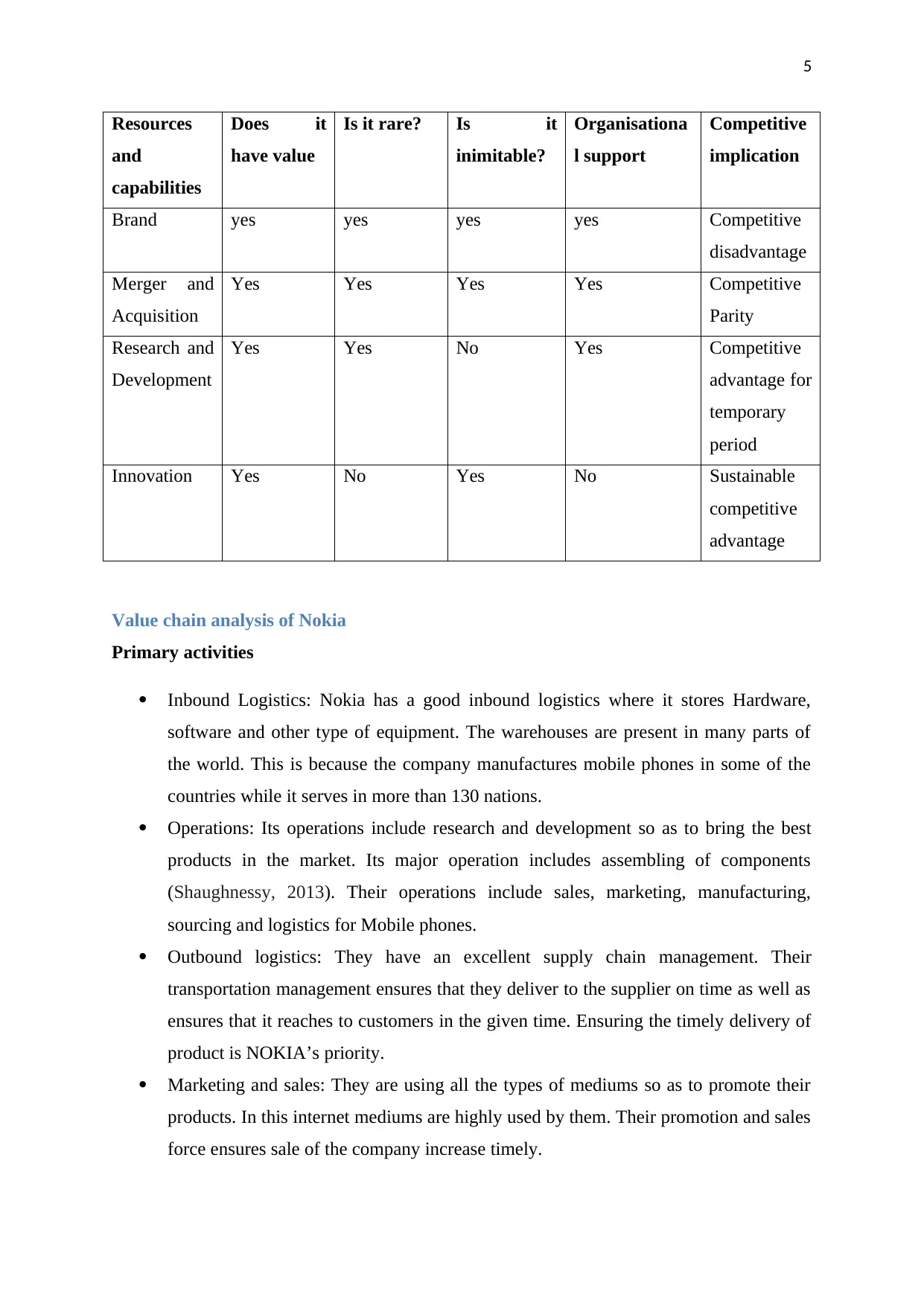
5
Resources
and
capabilities
Does it
have value
Is it rare? Is it
inimitable?
Organisationa
l support
Competitive
implication
Brand yes yes yes yes Competitive
disadvantage
Merger and
Acquisition
Yes Yes Yes Yes Competitive
Parity
Research and
Development
Yes Yes No Yes Competitive
advantage for
temporary
period
Innovation Yes No Yes No Sustainable
competitive
advantage
Value chain analysis of Nokia
Primary activities
Inbound Logistics: Nokia has a good inbound logistics where it stores Hardware,
software and other type of equipment. The warehouses are present in many parts of
the world. This is because the company manufactures mobile phones in some of the
countries while it serves in more than 130 nations.
Operations: Its operations include research and development so as to bring the best
products in the market. Its major operation includes assembling of components
(Shaughnessy, 2013). Their operations include sales, marketing, manufacturing,
sourcing and logistics for Mobile phones.
Outbound logistics: They have an excellent supply chain management. Their
transportation management ensures that they deliver to the supplier on time as well as
ensures that it reaches to customers in the given time. Ensuring the timely delivery of
product is NOKIA’s priority.
Marketing and sales: They are using all the types of mediums so as to promote their
products. In this internet mediums are highly used by them. Their promotion and sales
force ensures sale of the company increase timely.
Resources
and
capabilities
Does it
have value
Is it rare? Is it
inimitable?
Organisationa
l support
Competitive
implication
Brand yes yes yes yes Competitive
disadvantage
Merger and
Acquisition
Yes Yes Yes Yes Competitive
Parity
Research and
Development
Yes Yes No Yes Competitive
advantage for
temporary
period
Innovation Yes No Yes No Sustainable
competitive
advantage
Value chain analysis of Nokia
Primary activities
Inbound Logistics: Nokia has a good inbound logistics where it stores Hardware,
software and other type of equipment. The warehouses are present in many parts of
the world. This is because the company manufactures mobile phones in some of the
countries while it serves in more than 130 nations.
Operations: Its operations include research and development so as to bring the best
products in the market. Its major operation includes assembling of components
(Shaughnessy, 2013). Their operations include sales, marketing, manufacturing,
sourcing and logistics for Mobile phones.
Outbound logistics: They have an excellent supply chain management. Their
transportation management ensures that they deliver to the supplier on time as well as
ensures that it reaches to customers in the given time. Ensuring the timely delivery of
product is NOKIA’s priority.
Marketing and sales: They are using all the types of mediums so as to promote their
products. In this internet mediums are highly used by them. Their promotion and sales
force ensures sale of the company increase timely.
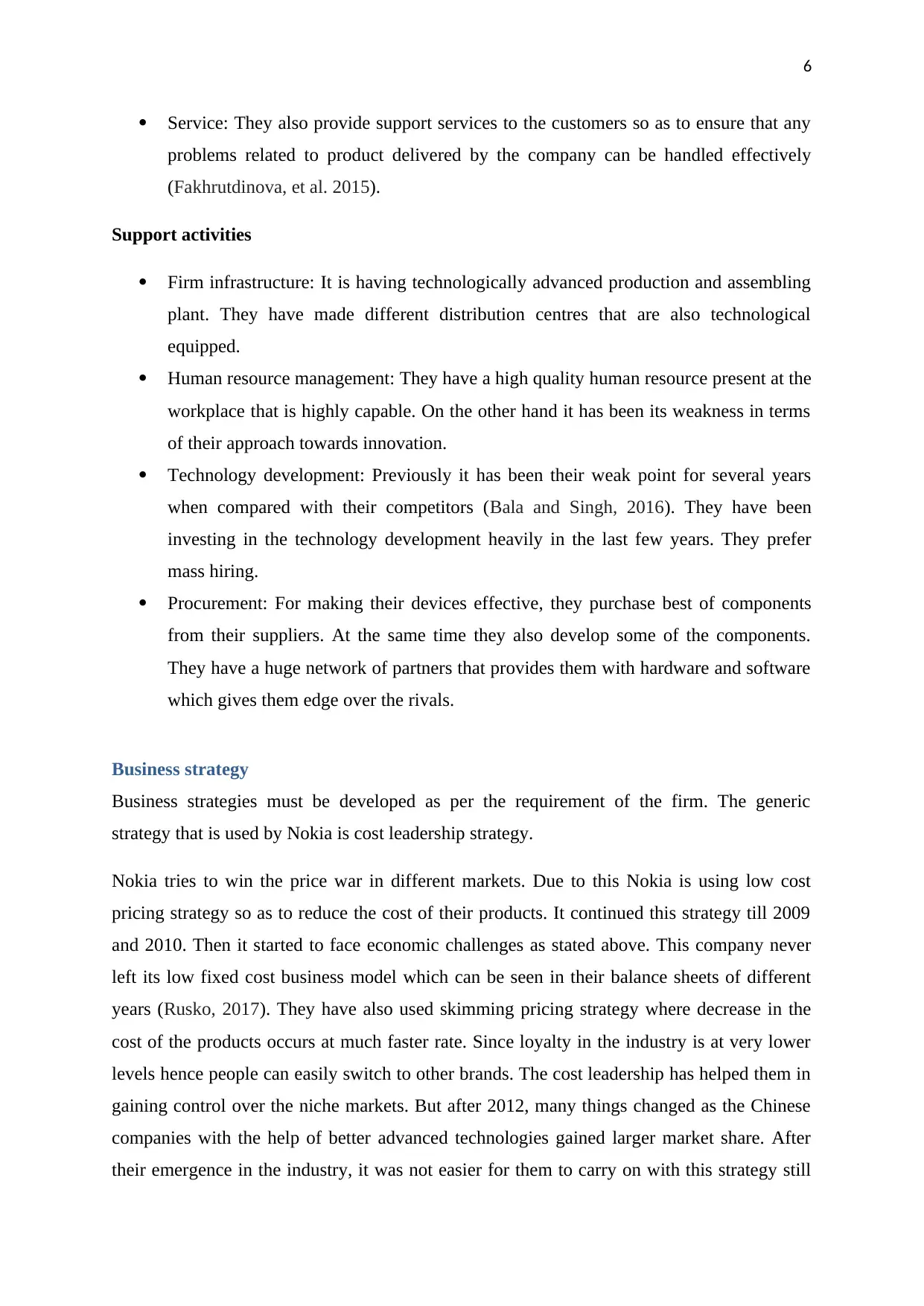
6
Service: They also provide support services to the customers so as to ensure that any
problems related to product delivered by the company can be handled effectively
(Fakhrutdinova, et al. 2015).
Support activities
Firm infrastructure: It is having technologically advanced production and assembling
plant. They have made different distribution centres that are also technological
equipped.
Human resource management: They have a high quality human resource present at the
workplace that is highly capable. On the other hand it has been its weakness in terms
of their approach towards innovation.
Technology development: Previously it has been their weak point for several years
when compared with their competitors (Bala and Singh, 2016). They have been
investing in the technology development heavily in the last few years. They prefer
mass hiring.
Procurement: For making their devices effective, they purchase best of components
from their suppliers. At the same time they also develop some of the components.
They have a huge network of partners that provides them with hardware and software
which gives them edge over the rivals.
Business strategy
Business strategies must be developed as per the requirement of the firm. The generic
strategy that is used by Nokia is cost leadership strategy.
Nokia tries to win the price war in different markets. Due to this Nokia is using low cost
pricing strategy so as to reduce the cost of their products. It continued this strategy till 2009
and 2010. Then it started to face economic challenges as stated above. This company never
left its low fixed cost business model which can be seen in their balance sheets of different
years (Rusko, 2017). They have also used skimming pricing strategy where decrease in the
cost of the products occurs at much faster rate. Since loyalty in the industry is at very lower
levels hence people can easily switch to other brands. The cost leadership has helped them in
gaining control over the niche markets. But after 2012, many things changed as the Chinese
companies with the help of better advanced technologies gained larger market share. After
their emergence in the industry, it was not easier for them to carry on with this strategy still
Service: They also provide support services to the customers so as to ensure that any
problems related to product delivered by the company can be handled effectively
(Fakhrutdinova, et al. 2015).
Support activities
Firm infrastructure: It is having technologically advanced production and assembling
plant. They have made different distribution centres that are also technological
equipped.
Human resource management: They have a high quality human resource present at the
workplace that is highly capable. On the other hand it has been its weakness in terms
of their approach towards innovation.
Technology development: Previously it has been their weak point for several years
when compared with their competitors (Bala and Singh, 2016). They have been
investing in the technology development heavily in the last few years. They prefer
mass hiring.
Procurement: For making their devices effective, they purchase best of components
from their suppliers. At the same time they also develop some of the components.
They have a huge network of partners that provides them with hardware and software
which gives them edge over the rivals.
Business strategy
Business strategies must be developed as per the requirement of the firm. The generic
strategy that is used by Nokia is cost leadership strategy.
Nokia tries to win the price war in different markets. Due to this Nokia is using low cost
pricing strategy so as to reduce the cost of their products. It continued this strategy till 2009
and 2010. Then it started to face economic challenges as stated above. This company never
left its low fixed cost business model which can be seen in their balance sheets of different
years (Rusko, 2017). They have also used skimming pricing strategy where decrease in the
cost of the products occurs at much faster rate. Since loyalty in the industry is at very lower
levels hence people can easily switch to other brands. The cost leadership has helped them in
gaining control over the niche markets. But after 2012, many things changed as the Chinese
companies with the help of better advanced technologies gained larger market share. After
their emergence in the industry, it was not easier for them to carry on with this strategy still
Paraphrase This Document
Need a fresh take? Get an instant paraphrase of this document with our AI Paraphraser
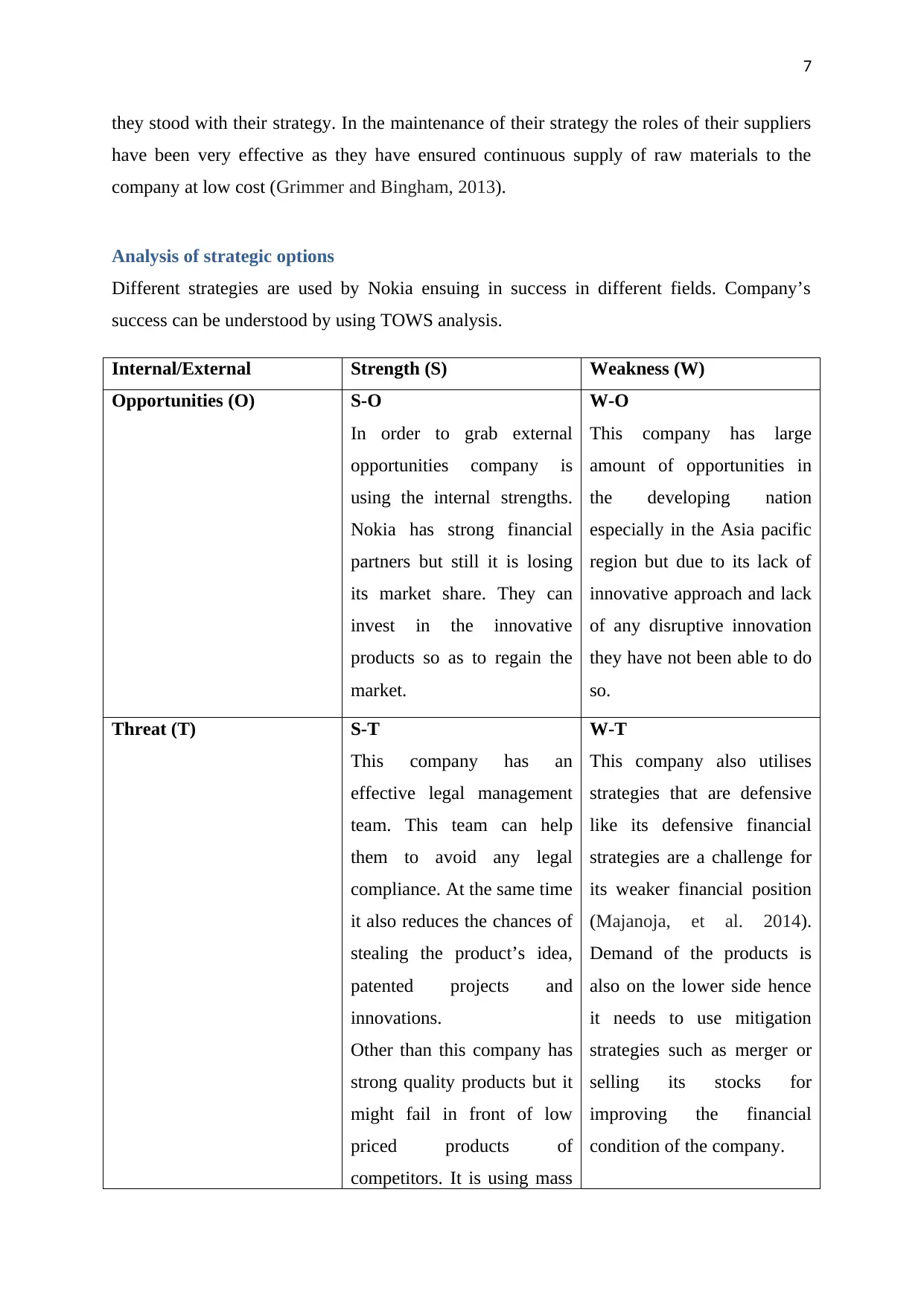
7
they stood with their strategy. In the maintenance of their strategy the roles of their suppliers
have been very effective as they have ensured continuous supply of raw materials to the
company at low cost (Grimmer and Bingham, 2013).
Analysis of strategic options
Different strategies are used by Nokia ensuing in success in different fields. Company’s
success can be understood by using TOWS analysis.
Internal/External Strength (S) Weakness (W)
Opportunities (O) S-O
In order to grab external
opportunities company is
using the internal strengths.
Nokia has strong financial
partners but still it is losing
its market share. They can
invest in the innovative
products so as to regain the
market.
W-O
This company has large
amount of opportunities in
the developing nation
especially in the Asia pacific
region but due to its lack of
innovative approach and lack
of any disruptive innovation
they have not been able to do
so.
Threat (T) S-T
This company has an
effective legal management
team. This team can help
them to avoid any legal
compliance. At the same time
it also reduces the chances of
stealing the product’s idea,
patented projects and
innovations.
Other than this company has
strong quality products but it
might fail in front of low
priced products of
competitors. It is using mass
W-T
This company also utilises
strategies that are defensive
like its defensive financial
strategies are a challenge for
its weaker financial position
(Majanoja, et al. 2014).
Demand of the products is
also on the lower side hence
it needs to use mitigation
strategies such as merger or
selling its stocks for
improving the financial
condition of the company.
they stood with their strategy. In the maintenance of their strategy the roles of their suppliers
have been very effective as they have ensured continuous supply of raw materials to the
company at low cost (Grimmer and Bingham, 2013).
Analysis of strategic options
Different strategies are used by Nokia ensuing in success in different fields. Company’s
success can be understood by using TOWS analysis.
Internal/External Strength (S) Weakness (W)
Opportunities (O) S-O
In order to grab external
opportunities company is
using the internal strengths.
Nokia has strong financial
partners but still it is losing
its market share. They can
invest in the innovative
products so as to regain the
market.
W-O
This company has large
amount of opportunities in
the developing nation
especially in the Asia pacific
region but due to its lack of
innovative approach and lack
of any disruptive innovation
they have not been able to do
so.
Threat (T) S-T
This company has an
effective legal management
team. This team can help
them to avoid any legal
compliance. At the same time
it also reduces the chances of
stealing the product’s idea,
patented projects and
innovations.
Other than this company has
strong quality products but it
might fail in front of low
priced products of
competitors. It is using mass
W-T
This company also utilises
strategies that are defensive
like its defensive financial
strategies are a challenge for
its weaker financial position
(Majanoja, et al. 2014).
Demand of the products is
also on the lower side hence
it needs to use mitigation
strategies such as merger or
selling its stocks for
improving the financial
condition of the company.
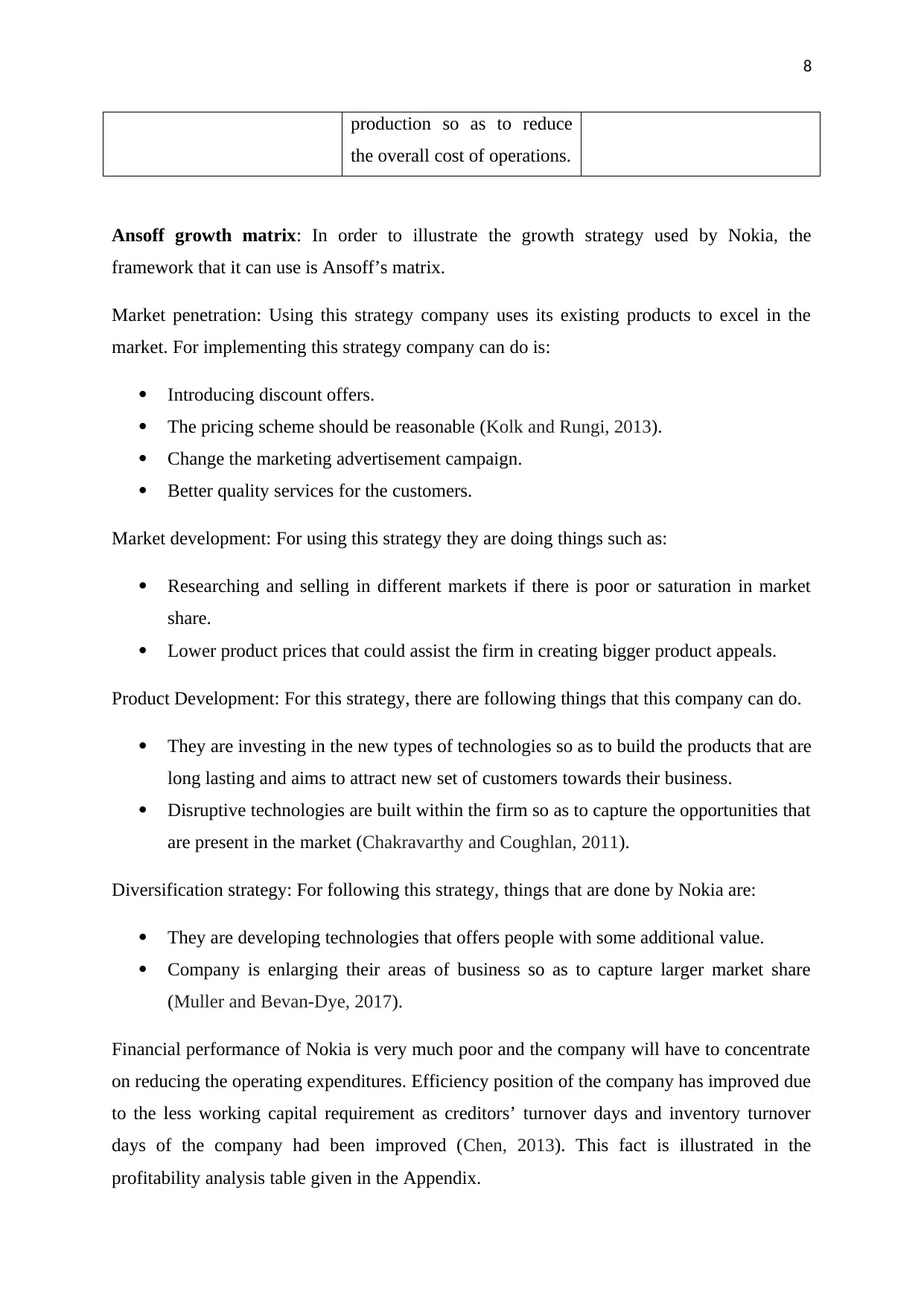
8
production so as to reduce
the overall cost of operations.
Ansoff growth matrix: In order to illustrate the growth strategy used by Nokia, the
framework that it can use is Ansoff’s matrix.
Market penetration: Using this strategy company uses its existing products to excel in the
market. For implementing this strategy company can do is:
Introducing discount offers.
The pricing scheme should be reasonable (Kolk and Rungi, 2013).
Change the marketing advertisement campaign.
Better quality services for the customers.
Market development: For using this strategy they are doing things such as:
Researching and selling in different markets if there is poor or saturation in market
share.
Lower product prices that could assist the firm in creating bigger product appeals.
Product Development: For this strategy, there are following things that this company can do.
They are investing in the new types of technologies so as to build the products that are
long lasting and aims to attract new set of customers towards their business.
Disruptive technologies are built within the firm so as to capture the opportunities that
are present in the market (Chakravarthy and Coughlan, 2011).
Diversification strategy: For following this strategy, things that are done by Nokia are:
They are developing technologies that offers people with some additional value.
Company is enlarging their areas of business so as to capture larger market share
(Muller and Bevan-Dye, 2017).
Financial performance of Nokia is very much poor and the company will have to concentrate
on reducing the operating expenditures. Efficiency position of the company has improved due
to the less working capital requirement as creditors’ turnover days and inventory turnover
days of the company had been improved (Chen, 2013). This fact is illustrated in the
profitability analysis table given in the Appendix.
production so as to reduce
the overall cost of operations.
Ansoff growth matrix: In order to illustrate the growth strategy used by Nokia, the
framework that it can use is Ansoff’s matrix.
Market penetration: Using this strategy company uses its existing products to excel in the
market. For implementing this strategy company can do is:
Introducing discount offers.
The pricing scheme should be reasonable (Kolk and Rungi, 2013).
Change the marketing advertisement campaign.
Better quality services for the customers.
Market development: For using this strategy they are doing things such as:
Researching and selling in different markets if there is poor or saturation in market
share.
Lower product prices that could assist the firm in creating bigger product appeals.
Product Development: For this strategy, there are following things that this company can do.
They are investing in the new types of technologies so as to build the products that are
long lasting and aims to attract new set of customers towards their business.
Disruptive technologies are built within the firm so as to capture the opportunities that
are present in the market (Chakravarthy and Coughlan, 2011).
Diversification strategy: For following this strategy, things that are done by Nokia are:
They are developing technologies that offers people with some additional value.
Company is enlarging their areas of business so as to capture larger market share
(Muller and Bevan-Dye, 2017).
Financial performance of Nokia is very much poor and the company will have to concentrate
on reducing the operating expenditures. Efficiency position of the company has improved due
to the less working capital requirement as creditors’ turnover days and inventory turnover
days of the company had been improved (Chen, 2013). This fact is illustrated in the
profitability analysis table given in the Appendix.
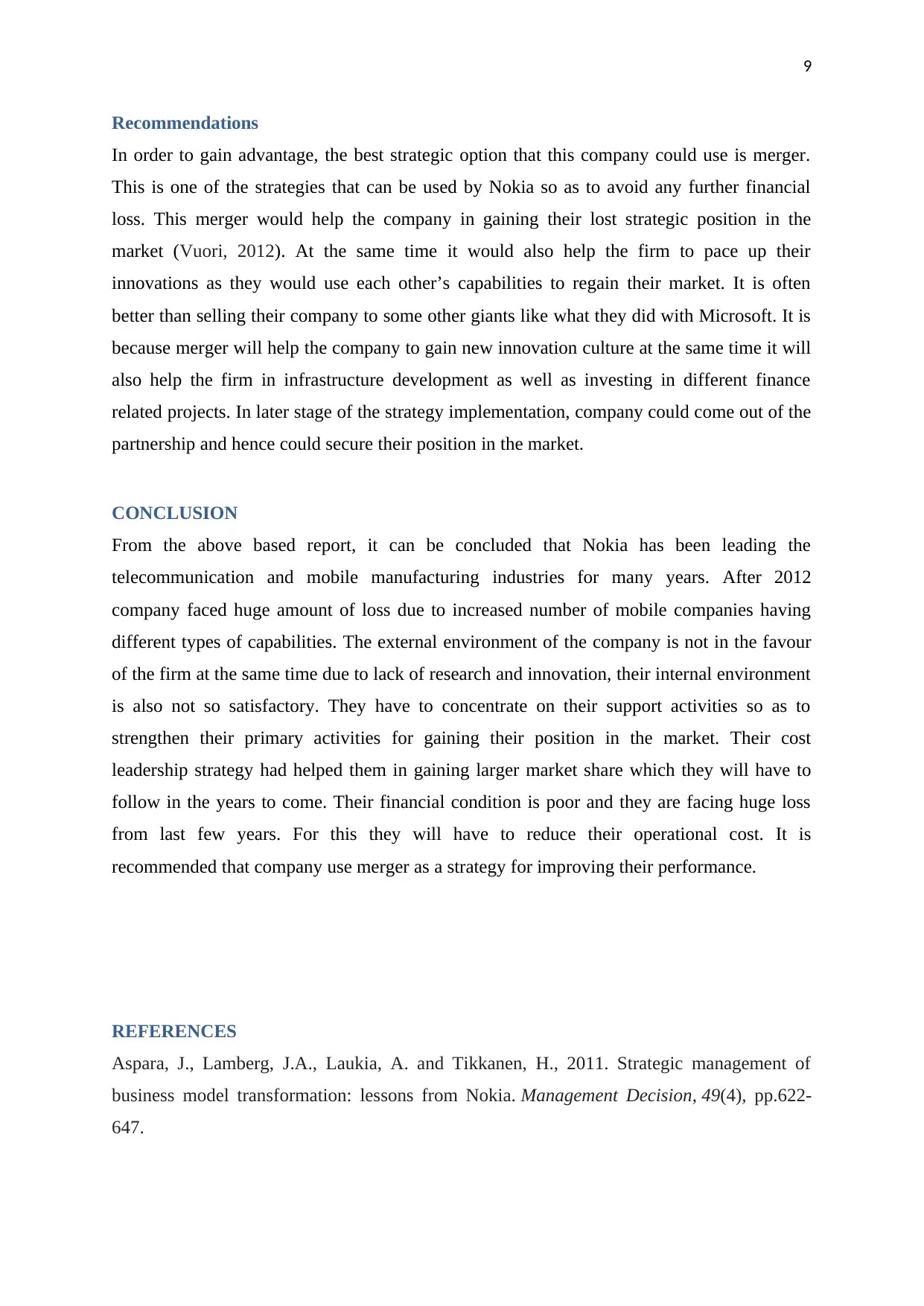
9
Recommendations
In order to gain advantage, the best strategic option that this company could use is merger.
This is one of the strategies that can be used by Nokia so as to avoid any further financial
loss. This merger would help the company in gaining their lost strategic position in the
market (Vuori, 2012). At the same time it would also help the firm to pace up their
innovations as they would use each other’s capabilities to regain their market. It is often
better than selling their company to some other giants like what they did with Microsoft. It is
because merger will help the company to gain new innovation culture at the same time it will
also help the firm in infrastructure development as well as investing in different finance
related projects. In later stage of the strategy implementation, company could come out of the
partnership and hence could secure their position in the market.
CONCLUSION
From the above based report, it can be concluded that Nokia has been leading the
telecommunication and mobile manufacturing industries for many years. After 2012
company faced huge amount of loss due to increased number of mobile companies having
different types of capabilities. The external environment of the company is not in the favour
of the firm at the same time due to lack of research and innovation, their internal environment
is also not so satisfactory. They have to concentrate on their support activities so as to
strengthen their primary activities for gaining their position in the market. Their cost
leadership strategy had helped them in gaining larger market share which they will have to
follow in the years to come. Their financial condition is poor and they are facing huge loss
from last few years. For this they will have to reduce their operational cost. It is
recommended that company use merger as a strategy for improving their performance.
REFERENCES
Aspara, J., Lamberg, J.A., Laukia, A. and Tikkanen, H., 2011. Strategic management of
business model transformation: lessons from Nokia. Management Decision, 49(4), pp.622-
647.
Recommendations
In order to gain advantage, the best strategic option that this company could use is merger.
This is one of the strategies that can be used by Nokia so as to avoid any further financial
loss. This merger would help the company in gaining their lost strategic position in the
market (Vuori, 2012). At the same time it would also help the firm to pace up their
innovations as they would use each other’s capabilities to regain their market. It is often
better than selling their company to some other giants like what they did with Microsoft. It is
because merger will help the company to gain new innovation culture at the same time it will
also help the firm in infrastructure development as well as investing in different finance
related projects. In later stage of the strategy implementation, company could come out of the
partnership and hence could secure their position in the market.
CONCLUSION
From the above based report, it can be concluded that Nokia has been leading the
telecommunication and mobile manufacturing industries for many years. After 2012
company faced huge amount of loss due to increased number of mobile companies having
different types of capabilities. The external environment of the company is not in the favour
of the firm at the same time due to lack of research and innovation, their internal environment
is also not so satisfactory. They have to concentrate on their support activities so as to
strengthen their primary activities for gaining their position in the market. Their cost
leadership strategy had helped them in gaining larger market share which they will have to
follow in the years to come. Their financial condition is poor and they are facing huge loss
from last few years. For this they will have to reduce their operational cost. It is
recommended that company use merger as a strategy for improving their performance.
REFERENCES
Aspara, J., Lamberg, J.A., Laukia, A. and Tikkanen, H., 2011. Strategic management of
business model transformation: lessons from Nokia. Management Decision, 49(4), pp.622-
647.
Secure Best Marks with AI Grader
Need help grading? Try our AI Grader for instant feedback on your assignments.
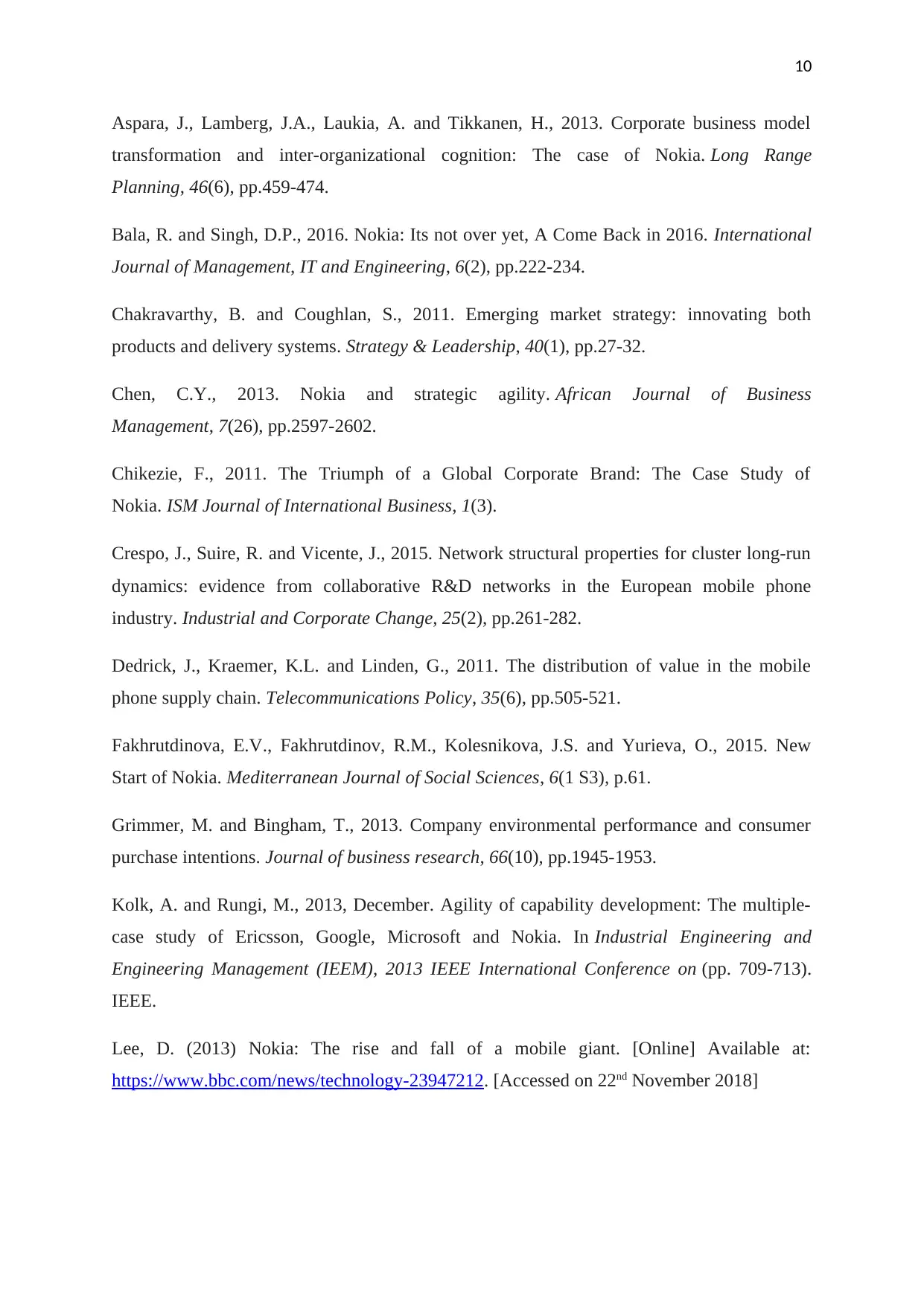
10
Aspara, J., Lamberg, J.A., Laukia, A. and Tikkanen, H., 2013. Corporate business model
transformation and inter-organizational cognition: The case of Nokia. Long Range
Planning, 46(6), pp.459-474.
Bala, R. and Singh, D.P., 2016. Nokia: Its not over yet, A Come Back in 2016. International
Journal of Management, IT and Engineering, 6(2), pp.222-234.
Chakravarthy, B. and Coughlan, S., 2011. Emerging market strategy: innovating both
products and delivery systems. Strategy & Leadership, 40(1), pp.27-32.
Chen, C.Y., 2013. Nokia and strategic agility. African Journal of Business
Management, 7(26), pp.2597-2602.
Chikezie, F., 2011. The Triumph of a Global Corporate Brand: The Case Study of
Nokia. ISM Journal of International Business, 1(3).
Crespo, J., Suire, R. and Vicente, J., 2015. Network structural properties for cluster long-run
dynamics: evidence from collaborative R&D networks in the European mobile phone
industry. Industrial and Corporate Change, 25(2), pp.261-282.
Dedrick, J., Kraemer, K.L. and Linden, G., 2011. The distribution of value in the mobile
phone supply chain. Telecommunications Policy, 35(6), pp.505-521.
Fakhrutdinova, E.V., Fakhrutdinov, R.M., Kolesnikova, J.S. and Yurieva, O., 2015. New
Start of Nokia. Mediterranean Journal of Social Sciences, 6(1 S3), p.61.
Grimmer, M. and Bingham, T., 2013. Company environmental performance and consumer
purchase intentions. Journal of business research, 66(10), pp.1945-1953.
Kolk, A. and Rungi, M., 2013, December. Agility of capability development: The multiple-
case study of Ericsson, Google, Microsoft and Nokia. In Industrial Engineering and
Engineering Management (IEEM), 2013 IEEE International Conference on (pp. 709-713).
IEEE.
Lee, D. (2013) Nokia: The rise and fall of a mobile giant. [Online] Available at:
https://www.bbc.com/news/technology-23947212. [Accessed on 22nd November 2018]
Aspara, J., Lamberg, J.A., Laukia, A. and Tikkanen, H., 2013. Corporate business model
transformation and inter-organizational cognition: The case of Nokia. Long Range
Planning, 46(6), pp.459-474.
Bala, R. and Singh, D.P., 2016. Nokia: Its not over yet, A Come Back in 2016. International
Journal of Management, IT and Engineering, 6(2), pp.222-234.
Chakravarthy, B. and Coughlan, S., 2011. Emerging market strategy: innovating both
products and delivery systems. Strategy & Leadership, 40(1), pp.27-32.
Chen, C.Y., 2013. Nokia and strategic agility. African Journal of Business
Management, 7(26), pp.2597-2602.
Chikezie, F., 2011. The Triumph of a Global Corporate Brand: The Case Study of
Nokia. ISM Journal of International Business, 1(3).
Crespo, J., Suire, R. and Vicente, J., 2015. Network structural properties for cluster long-run
dynamics: evidence from collaborative R&D networks in the European mobile phone
industry. Industrial and Corporate Change, 25(2), pp.261-282.
Dedrick, J., Kraemer, K.L. and Linden, G., 2011. The distribution of value in the mobile
phone supply chain. Telecommunications Policy, 35(6), pp.505-521.
Fakhrutdinova, E.V., Fakhrutdinov, R.M., Kolesnikova, J.S. and Yurieva, O., 2015. New
Start of Nokia. Mediterranean Journal of Social Sciences, 6(1 S3), p.61.
Grimmer, M. and Bingham, T., 2013. Company environmental performance and consumer
purchase intentions. Journal of business research, 66(10), pp.1945-1953.
Kolk, A. and Rungi, M., 2013, December. Agility of capability development: The multiple-
case study of Ericsson, Google, Microsoft and Nokia. In Industrial Engineering and
Engineering Management (IEEM), 2013 IEEE International Conference on (pp. 709-713).
IEEE.
Lee, D. (2013) Nokia: The rise and fall of a mobile giant. [Online] Available at:
https://www.bbc.com/news/technology-23947212. [Accessed on 22nd November 2018]
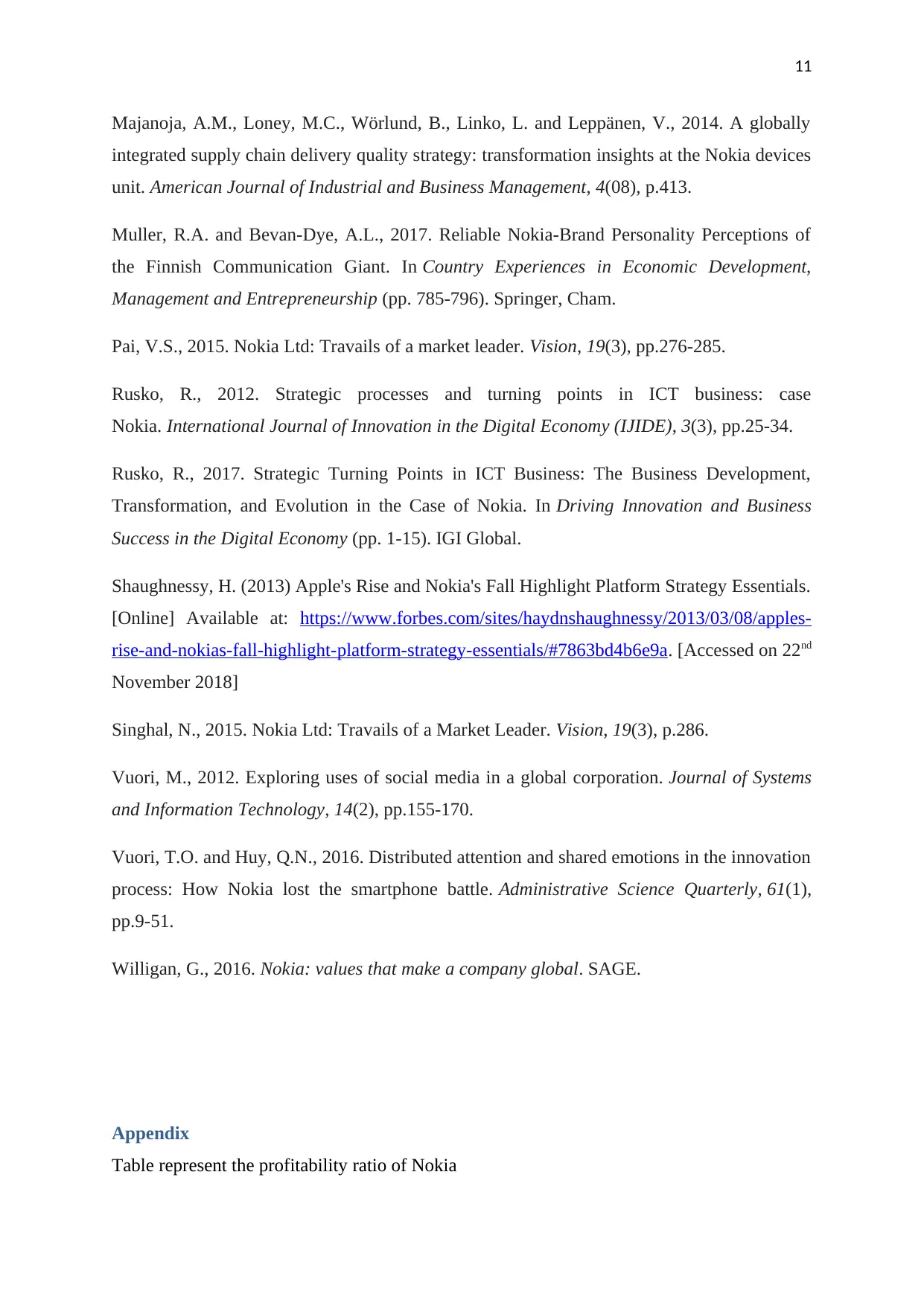
11
Majanoja, A.M., Loney, M.C., Wörlund, B., Linko, L. and Leppänen, V., 2014. A globally
integrated supply chain delivery quality strategy: transformation insights at the Nokia devices
unit. American Journal of Industrial and Business Management, 4(08), p.413.
Muller, R.A. and Bevan-Dye, A.L., 2017. Reliable Nokia-Brand Personality Perceptions of
the Finnish Communication Giant. In Country Experiences in Economic Development,
Management and Entrepreneurship (pp. 785-796). Springer, Cham.
Pai, V.S., 2015. Nokia Ltd: Travails of a market leader. Vision, 19(3), pp.276-285.
Rusko, R., 2012. Strategic processes and turning points in ICT business: case
Nokia. International Journal of Innovation in the Digital Economy (IJIDE), 3(3), pp.25-34.
Rusko, R., 2017. Strategic Turning Points in ICT Business: The Business Development,
Transformation, and Evolution in the Case of Nokia. In Driving Innovation and Business
Success in the Digital Economy (pp. 1-15). IGI Global.
Shaughnessy, H. (2013) Apple's Rise and Nokia's Fall Highlight Platform Strategy Essentials.
[Online] Available at: https://www.forbes.com/sites/haydnshaughnessy/2013/03/08/apples-
rise-and-nokias-fall-highlight-platform-strategy-essentials/#7863bd4b6e9a. [Accessed on 22nd
November 2018]
Singhal, N., 2015. Nokia Ltd: Travails of a Market Leader. Vision, 19(3), p.286.
Vuori, M., 2012. Exploring uses of social media in a global corporation. Journal of Systems
and Information Technology, 14(2), pp.155-170.
Vuori, T.O. and Huy, Q.N., 2016. Distributed attention and shared emotions in the innovation
process: How Nokia lost the smartphone battle. Administrative Science Quarterly, 61(1),
pp.9-51.
Willigan, G., 2016. Nokia: values that make a company global. SAGE.
Appendix
Table represent the profitability ratio of Nokia
Majanoja, A.M., Loney, M.C., Wörlund, B., Linko, L. and Leppänen, V., 2014. A globally
integrated supply chain delivery quality strategy: transformation insights at the Nokia devices
unit. American Journal of Industrial and Business Management, 4(08), p.413.
Muller, R.A. and Bevan-Dye, A.L., 2017. Reliable Nokia-Brand Personality Perceptions of
the Finnish Communication Giant. In Country Experiences in Economic Development,
Management and Entrepreneurship (pp. 785-796). Springer, Cham.
Pai, V.S., 2015. Nokia Ltd: Travails of a market leader. Vision, 19(3), pp.276-285.
Rusko, R., 2012. Strategic processes and turning points in ICT business: case
Nokia. International Journal of Innovation in the Digital Economy (IJIDE), 3(3), pp.25-34.
Rusko, R., 2017. Strategic Turning Points in ICT Business: The Business Development,
Transformation, and Evolution in the Case of Nokia. In Driving Innovation and Business
Success in the Digital Economy (pp. 1-15). IGI Global.
Shaughnessy, H. (2013) Apple's Rise and Nokia's Fall Highlight Platform Strategy Essentials.
[Online] Available at: https://www.forbes.com/sites/haydnshaughnessy/2013/03/08/apples-
rise-and-nokias-fall-highlight-platform-strategy-essentials/#7863bd4b6e9a. [Accessed on 22nd
November 2018]
Singhal, N., 2015. Nokia Ltd: Travails of a Market Leader. Vision, 19(3), p.286.
Vuori, M., 2012. Exploring uses of social media in a global corporation. Journal of Systems
and Information Technology, 14(2), pp.155-170.
Vuori, T.O. and Huy, Q.N., 2016. Distributed attention and shared emotions in the innovation
process: How Nokia lost the smartphone battle. Administrative Science Quarterly, 61(1),
pp.9-51.
Willigan, G., 2016. Nokia: values that make a company global. SAGE.
Appendix
Table represent the profitability ratio of Nokia
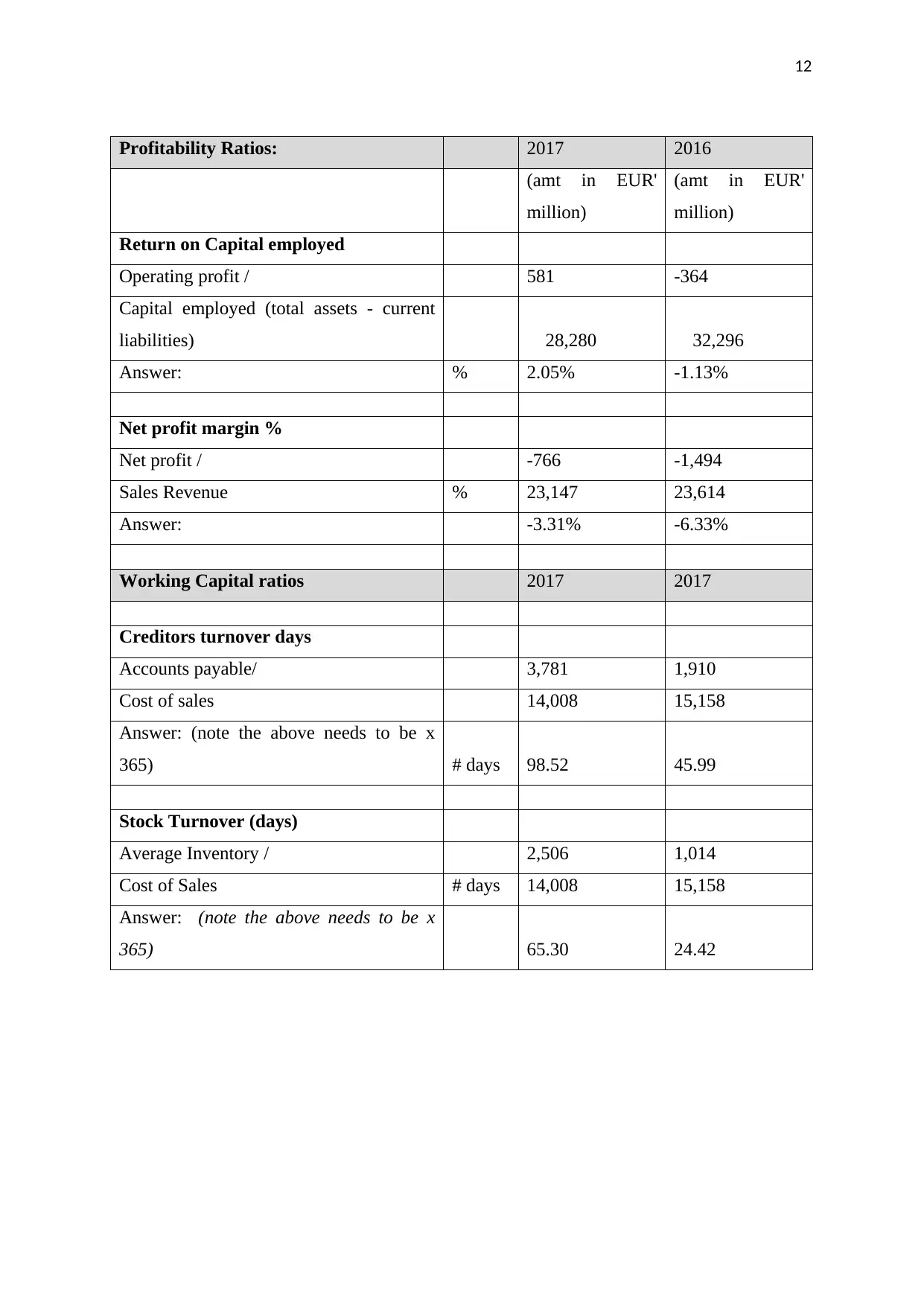
12
Profitability Ratios: 2017 2016
(amt in EUR'
million)
(amt in EUR'
million)
Return on Capital employed
Operating profit / 581 -364
Capital employed (total assets - current
liabilities) 28,280 32,296
Answer: % 2.05% -1.13%
Net profit margin %
Net profit / -766 -1,494
Sales Revenue % 23,147 23,614
Answer: -3.31% -6.33%
Working Capital ratios 2017 2017
Creditors turnover days
Accounts payable/ 3,781 1,910
Cost of sales 14,008 15,158
Answer: (note the above needs to be x
365) # days 98.52 45.99
Stock Turnover (days)
Average Inventory / 2,506 1,014
Cost of Sales # days 14,008 15,158
Answer: (note the above needs to be x
365) 65.30 24.42
Profitability Ratios: 2017 2016
(amt in EUR'
million)
(amt in EUR'
million)
Return on Capital employed
Operating profit / 581 -364
Capital employed (total assets - current
liabilities) 28,280 32,296
Answer: % 2.05% -1.13%
Net profit margin %
Net profit / -766 -1,494
Sales Revenue % 23,147 23,614
Answer: -3.31% -6.33%
Working Capital ratios 2017 2017
Creditors turnover days
Accounts payable/ 3,781 1,910
Cost of sales 14,008 15,158
Answer: (note the above needs to be x
365) # days 98.52 45.99
Stock Turnover (days)
Average Inventory / 2,506 1,014
Cost of Sales # days 14,008 15,158
Answer: (note the above needs to be x
365) 65.30 24.42
Paraphrase This Document
Need a fresh take? Get an instant paraphrase of this document with our AI Paraphraser

13
1 out of 14
Your All-in-One AI-Powered Toolkit for Academic Success.
+13062052269
info@desklib.com
Available 24*7 on WhatsApp / Email
![[object Object]](/_next/static/media/star-bottom.7253800d.svg)
Unlock your academic potential
© 2024 | Zucol Services PVT LTD | All rights reserved.





